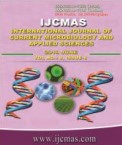


 National Academy of Agricultural Sciences (NAAS)
National Academy of Agricultural Sciences (NAAS)

|
PRINT ISSN : 2319-7692
Online ISSN : 2319-7706 Issues : 12 per year Publisher : Excellent Publishers Email : editorijcmas@gmail.com / submit@ijcmas.com Editor-in-chief: Dr.M.Prakash Index Copernicus ICV 2018: 95.39 NAAS RATING 2020: 5.38 |
Candidiasis is one of the most predominant fungal infections that cause a major mortality of the patient. The epidemiology of candida infections have been witnessed a change round the world. We aimed to determine the distribution of candida species isolates from various clinical samples of patients in ICUs and evaluate its antifungal susceptibility to demonstrate the local resistance proï¬le and guiding empirical treatment for clinicians. This study included 714 Candida isolates. Candida species were identiï¬ed by MALDI-TOF mass spectrometry. Antifungal susceptibility tests were performed by Vitek 2 system. The percentage of NAC isolates (63.59%) was higher compared with C. albicans (36.41%). The highest resistance rate in candida species was against amphotericin B (11.56%). However there was no resistance to caspofungin and micafungin reported. Regarding to voriconazole and fluconazoleanti fungal, the resistance rate of C. albicans were 13.46% and 8.46% respectively while of NAC species were 6.53%, 5.1% respectively. All C. krusei isolates were resistance to fluconazole. The study revealed increased the incidence of NAC over time. Although no remarkable resistance for antifungal agents in our hospital, we establish a critical need to antifungal stewardship program to prevent reaching the era of predominant Multi- drug resistance strain of Candida.
 |
 |
 |
 |
 |